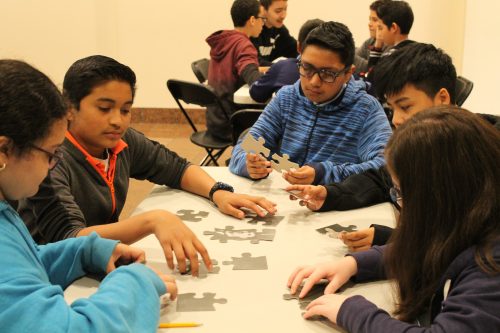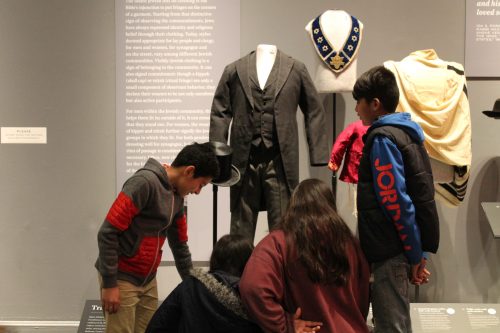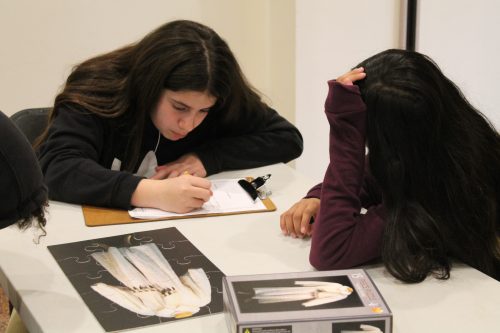Fashion Statement: Students as Storytellers Part 2

This post was written by JMM School Program Coordinator Paige Woodhouse. To read more posts from Paige, click here!
(This is Part 2 of a two-part blog post about the latest education programs offered at the Jewish Museum of Maryland for our special exhibits: Stitching History from the Holocaust and Fashion Statement. Missed Part 1? You can check it out here.)
At the Jewish Museum of Maryland, we are stories tellers. We are also storyfinders, storykeepers, and storyprotectors. We are finding new stories all the time. Our current special exhibit, Fashion Statement, is composed of items of clothing that tell stories about their wearers.
During their recent visit, students from John Ruhrah Elementary Middle School had the opportunity to become storytellers. Thinking critically and creatively, they worked in small groups to create stories about the clothing items on display in Fashion Statement.

Piecing together a puzzle is like piecing together the story of an object. As each new fact is discovered, another piece of the puzzle falls into place, eventually revealing the whole picture. The 6th to 8th-grade students started with a puzzle. Working together as a team, they completed the puzzle to reveal an item of clothing from the exhibit.

After locating their item in the exhibit, students made observations about it. Taking their cue from Nancy Patz’ book “Who Was the Woman Who Wore the Hat?” students asked questions that a researcher would ask when trying to learn more about an object in a Museum. What is the clothing item? What material, or materials, is it made of? Who wore it? Why do you think someone would wear this specific item? Why was it chosen to be on display by the Museum?

Then, mimicking the rhythmic lyrics of Nancy Patz’ book, students worked together to complete fill-in-the-blank stories for their items. Who was the person who wore the (blank) coat? What was she like? Was she (Blank)?

Taking an active role as the storyteller, students were empowered to think about what clothing represents. In the case of Stitching History from the Holocaust (see Part 1), clothing was a means for survival and representative of a talent lost to the world. In Fashion Statement, clothing is a way to express your identity.
At the end of the visit, students considered: What can we learn about people through their clothing? What can’t we learn about people from their clothing? What does clothing mean to you?
I encourage you to think about these questions as you visit Fashion Statement and explore how Jewish Marylanders, and all human beings, use clothing as one of the ways we assert who we are.
Thank you to the 6th to 8th-graders at John Ruhrah Elementary Middle School for visiting the Jewish Museum of Maryland this spring. If you are interested in bringing your school, summer camp, or group, please contact Paige Woodhouse, School Program Coordinator, at pwoodhouse@jewishmuseummd.org or 443-873-5167.
Not all stories fit on a label in an exhibit. Looking to learn more about some of the items on display? Check out some “extras” here.
